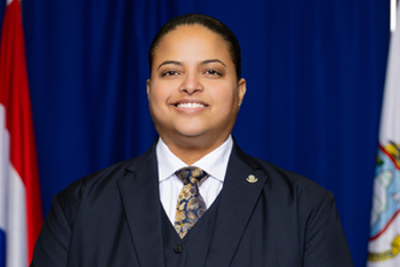 PHILIPSBURG: --- The Ministry of Education, Culture, Youth, and Sports Minister Melissa Gumbs continues to try to improve educational and recreational facilities across the island under the Emergency Recovery Project 1 (ERP1) and the Fostering Resilient Learning Project (FRLP). These efforts focus on repairing and upgrading schools and gymnasiums, addressing long-standing structural issues, and creating spaces that support both learning and community engagement.
PHILIPSBURG: --- The Ministry of Education, Culture, Youth, and Sports Minister Melissa Gumbs continues to try to improve educational and recreational facilities across the island under the Emergency Recovery Project 1 (ERP1) and the Fostering Resilient Learning Project (FRLP). These efforts focus on repairing and upgrading schools and gymnasiums, addressing long-standing structural issues, and creating spaces that support both learning and community engagement.
Progress of Sister Marie Laurence School Repairs
An essential milestone in the FRLP is the construction and rehabilitation of the Sister Marie Laurence School. Recently, the bidding process for this project concluded with one bid submitted. However, no local companies participated in the tender. While the limited bidding response presents a challenge, the Ministry, in collaboration with the National Recovery Program Bureau (NRPB), remains committed to moving this project forward.
The lack of local participation highlights a broader issue within large-scale infrastructure projects on the island, such as limited local contractor capacity or technical requirements that may hinder bids. Despite these challenges, the Ministry, supported by the NRPB and the World Bank, continues to push for the timely commencement of construction to deliver the much-needed facility upgrades.
Challenges and Adjustments in the Repair Process
Beyond the bidding hurdle for Sister Marie Laurence School, other facets of the ERP1 and FRLP have experienced their share of obstacles. The projects involve intricate collaboration between government ministries, international organizations, and the local private sector. Additionally, the approaching wind-down of the World Bank-administered trust fund in 2028 necessitates strict adherence to timelines. The Ministry plans to work collaboratively in upcoming committee meetings with the World Bank and NRPB to refine strategies and ensure alignment with deadlines.
Such coordination is pivotal in reallocating pending phases of school, gym, and sports facilities upgrades to alternate programs, enabling seamless progression without jeopardizing the funding timeline.
The Role of the World Bank and NRPB
At the core of these initiatives lies the steadfast support of the World Bank and NRPB. Funding and oversight from these entities have ensured that projects adhere to international safety, quality, and governance standards. These partnerships have been instrumental in weaving resilience into the rebuilding efforts, ensuring schools and recreational spaces can better withstand future hazards.
The World Bank’s global expertise, combined with NRPB’s localized project management, has created a framework for success. From setting clear guidelines for fair bidding processes to providing consistent monitoring, these bodies have demonstrated their commitment to fostering educational resilience in St. Martin.
Schools and gyms serve as the heart of the St. Maarten community. Beyond providing spaces for education, they also act as shelters during emergencies and venues for community-building activities. Upgrading these facilities is more than just a practical necessity; it is an investment in the well-being of students, educators, and families island-wide.
Modernized schools not only provide safer and more conducive environments for learning but also aim to inspire. Similarly, rehabilitated gyms and sports facilities promote physical health and create opportunities for youth development through sports and other extracurricular activities.
The Ministry of Education, Culture, Youth, and Sport is committed to ensuring the timely completion of these projects. Upcoming committee meetings with the World Bank and NRPB will serve as pivotal platforms for refining strategies and addressing existing challenges. Meanwhile, the Ministry is actively monitoring progress and keeping stakeholders informed every step of the way.
For students and the community, the results of these initiatives promise brighter prospects, a restored sense of normalcy, safer environments, and new opportunities to excel. These repairs are not just about revamping infrastructure; they represent a renewal of hope and a determined step towards a resilient future for St. Martin.
The continued collaboration of all stakeholders will be crucial to achieving these goals. As the projects advance, they will undoubtedly leave an enduring impact on education and community life in St. Maarten for generations to come.










